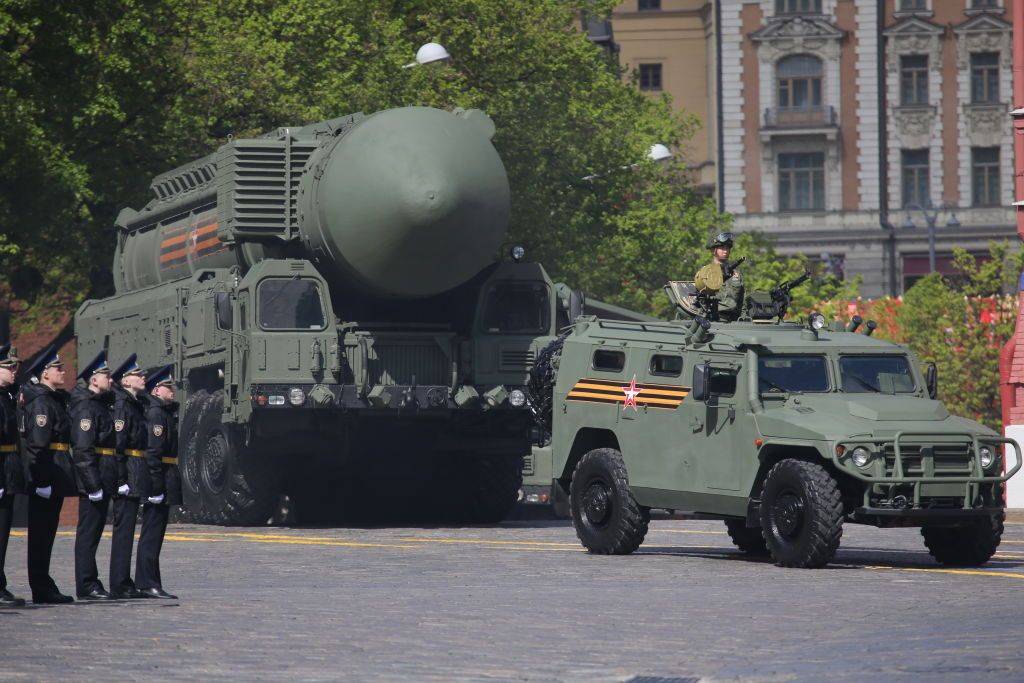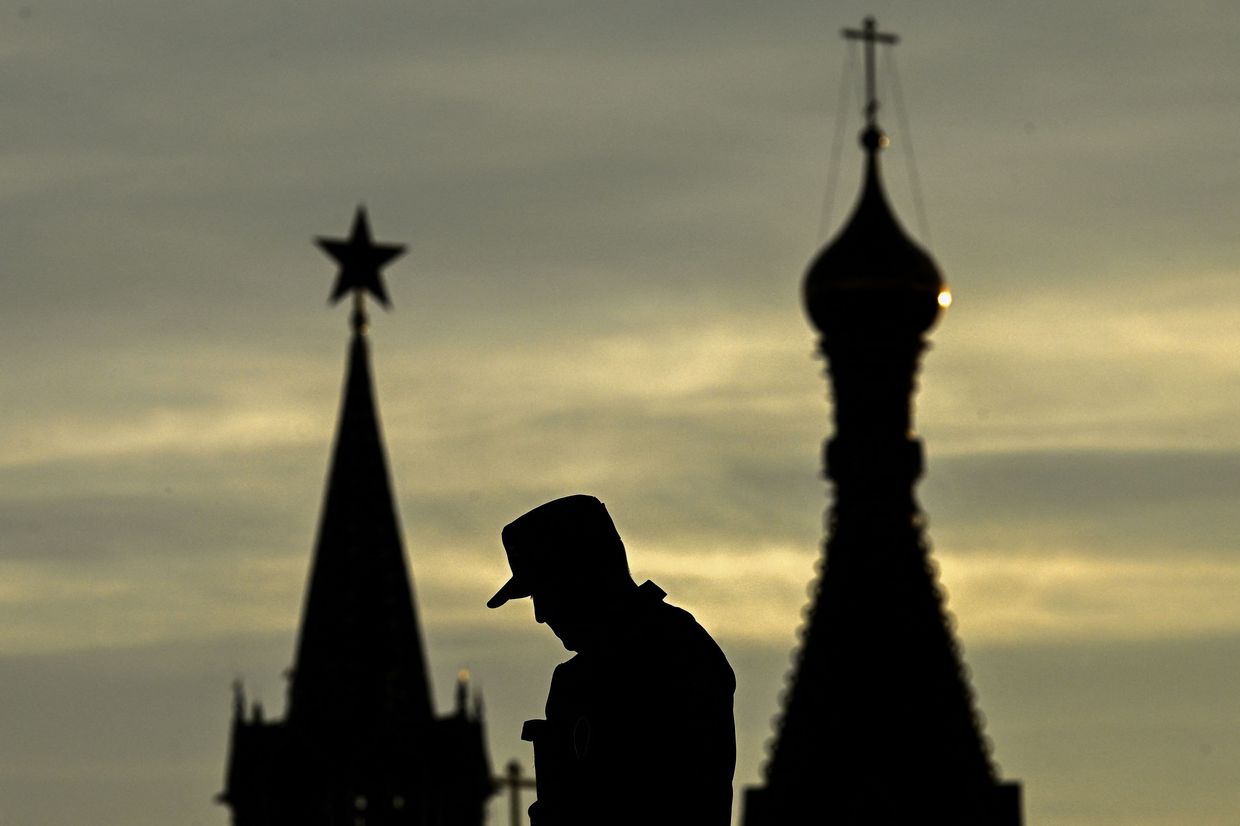
Opinion: Russia is leveraging gold and working with China to bypass Western sanctions
Russia’s evolving trade tactics, including the use of gold and informal networks, highlight the Kremlin’s resourcefulness in circumventing Western sanctions, with China playing a key role in its economic workarounds.
Russian President Vladimir Putin (R) shakes hands with Chinese President Xi Jinping (L) at a ceremony at Tiananmen Square in Beijing, China, on May 16, 2024. (Sergei Bobylyov /POOL/AFP via Getty Images)
Since the West imposed unprecedented economic pressure on Russia following its full-scale invasion of Ukraine, the country’s trade practices have undergone a dramatic transformation, with Russian international trade increasingly occurring in the shadows. Access to the goods it needs now depends on constant scheming. Given that Russia operates under informal rules, this shift comes naturally.
Understanding this — and, particularly, the role of Russia’s new patron, China — could help ensure that pressure on Russia’s war economy is applied most effectively.
History shows that when the Kremlin faces a crisis — such as a war or a five-year plan — officials and businesses become more entrepreneurial in an effort to meet extraordinary goals.
Today, the Kremlin is encouraging officials and businesses to develop new workarounds — informal or illicit activities — that undermine conventional trading practices. These include the sale of Russia’s most important commodity via a shadow fleet, the purchase of weapons with gold from Iran or North Korea, and a growing network of import-export entrepreneurs who channel foreign goods to Russia through third countries.
Russia’s most pressing trade challenge is how to pay foreign counterparts concerned about secondary sanctions, especially in China, on which Russia has become increasingly dependent for imports.
Three trends are clear. First, Russia is formalizing informal trading. This began in 2022 with the legalization of gray imports, but now includes barter trading and exchange in kind. Barter trading has a long history in Russia, given its commodity-based economy, with the state historically striking deals for natural resources. However, barter relies on willing trade partners, and it remains to be seen how widespread it will become.
Second, the Russian state is scrambling to create payment systems that avoid exposure to, or provide an alternative to, the dollar. As we saw during the recent BRICS conference in Kazan, these include central bank-backed digital currencies. While such systems may work in principle, Russian technologies often rely on foreign cooperation and components, and it remains unclear whether the Kremlin can count on uptake from its BRICS partners.

A third trend is the use of gold and other precious stones, such as diamonds, as payment. This may be Russia’s most promising workaround payment option. Russia is a major gold producer and hoarder, consistently producing over 300 tonnes of gold annually. Russian interests also control large stakes in gold-producing countries in Eurasia and Africa. Thus, even if Russia spends its gold, it has ample access to more.
As recent research by RAND has shown, over the last 20 years, Russia’s central bank has acquired nearly 2,000 tonnes of gold — more than any other country by a wide margin. Moreover, the state regularly adds to a vault controlled by the Ministry of Finance, which holds an undisclosed amount of gold and precious stones that can be used at Russian President Vladimir Putin’s discretion.
There is little doubt that Russia is already using gold to pay for goods it cannot procure conventionally, or for transactions it wishes to obscure. An open-source investigation by Sayari, for example, revealed that unsanctioned banks were trading gold for cash in Turkey. Russia has also partly paid Iranian drone manufacturer Sahara Thunder in gold for 6,000 Shahed drones and related equipment.
While it’s unclear how much of a role gold plays in Russia’s trade with China, it is certainly becoming a growing feature. Russian gold exports to China increased after the U.S., UK, and EU banned Russian gold imports in 2022. Chinese demand for gold has been very high from 2022 to the second half of this year, when rising gold prices slowed purchasing. According to World Gold Council data, the People’s Bank of China has acquired more gold during this period than any other country.
It’s plausible that Beijing, like Moscow, holds undisclosed gold, as its declared reserves represent less than 5% of its overall holdings — far less than comparable economies. Indeed, around half of global gold purchases since March are unaccounted for, and it’s unclear what is driving such high demand.
In 2023, China became a key hub for Russia’s international gold trade after secondary sanctions deterred the UAE, which had become Russia’s main partner after the West banned Russian gold imports. On the surface, China does not appear to covet Russian gold, given its security of supply and investments in foreign gold assets, including in Afghanistan, Ghana, and Tajikistan. Additionally, China does not hold significant investments in Russia’s largest gold mining companies. It’s also unclear how much Russian gold ore China now refines, since international demand for Russia-refined gold bars has fallen since 2022.
However, the development of gold relations deserves further attention, especially considering the rising demand for gold among Chinese consumers, which may increase due to concerns over the stability of the domestic economy and potential renewed trade tensions with the incoming U.S. administration.
If relations with the U.S. worsen, China may be more willing to collaborate with Russia in the creation of a de-dollarized trading bloc, where gold could play a significant role. This has already become an important rhetorical theme in their relations, and both Putin and Chinese President Xi Jinping have declared their intent to deepen cooperation at the BRICS summit.
Recent reports suggest that China is providing direct support to Russian defense production, signaling that China is more willing to risk Western sanctions than previously thought. In August, China tightened controls on payments with Russian companies, causing delays in bilateral trade.
However, it has not prevented traders from using gold to settle payments for Russian businesses. Reporting indicates that Russian companies have been selling gold in Hong Kong and depositing the proceeds in local bank accounts to pay Chinese suppliers in lieu of using yuan or rubles directly. In this way, China is tolerating Russian workarounds — a form of preemptive sanctions evasion.
Chinese tolerance for Russia-related risk is not unlimited, but it is clearly supporting Russia’s workaround trade. The pressure on Beijing to assist Moscow is unlikely to subside, and gold offers a range of possibilities to extend and obfuscate their cooperation.
Editor’s Note: This op-ed is based on the RAND report "Gold Rush: How Russia is using gold in wartime," authored by John Kennedy, Elena Grossfeld, and Zsofia Wolford, and Thomas Kenchington, and published on Sept. 9, 2024. The opinions expressed in the op-ed section are those of the authors and do not necessarily reflect the views of the Kyiv Independent.














